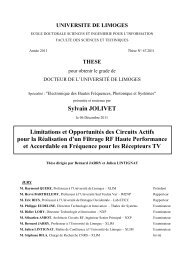Etude et conception d'un étage de mise en forme d'impulsions ultra ...
Etude et conception d'un étage de mise en forme d'impulsions ultra ...
Etude et conception d'un étage de mise en forme d'impulsions ultra ...
Create successful ePaper yourself
Turn your PDF publications into a flip-book with our unique Google optimized e-Paper software.
xxxii<br />
<strong>Etu<strong>de</strong></strong> <strong>et</strong> <strong>conception</strong> d’un <strong>étage</strong> <strong>de</strong> mies <strong>en</strong> <strong>forme</strong> d’impulsions <strong>ultra</strong> large-ban<strong>de</strong> <strong>de</strong> forte<br />
puissance<br />
Résumé<br />
Le travail prés<strong>en</strong>té dans c<strong>et</strong>te thèse concerne l’étu<strong>de</strong> <strong>et</strong> le développem<strong>en</strong>t d’un <strong>étage</strong> <strong>de</strong> <strong>mise</strong><br />
<strong>en</strong> <strong>forme</strong> d’impulsions bipolaires <strong>de</strong> forte puissance dans le domaine <strong>ultra</strong> large ban<strong>de</strong>. Ce soussystème<br />
est intégré au prototype <strong>de</strong> source <strong>de</strong> rayonnem<strong>en</strong>t pulsé GIMLI <strong>de</strong> l’ISL.<br />
Le système étudié répond à une exig<strong>en</strong>ce sévère <strong>de</strong> compacité. Il réalise la <strong>mise</strong> <strong>en</strong> <strong>forme</strong><br />
bipolaire d’une impulsion <strong>de</strong> forte puissance grâce au fonctionnem<strong>en</strong>t couplé <strong>de</strong> <strong>de</strong>ux éclateurs<br />
à gaz <strong>et</strong> d’une ligne Blumlein. L’<strong>en</strong>semble est alim<strong>en</strong>té par un générateur <strong>de</strong> Marx. La sortie est<br />
connectée sur une ant<strong>en</strong>ne dédiée. La <strong>conception</strong> a fait largem<strong>en</strong>t appel à la simulation numérique<br />
pour dim<strong>en</strong>sionner la ligne Blumlein ainsi que pour i<strong>de</strong>ntifier <strong>et</strong> limiter les zones <strong>de</strong> r<strong>en</strong>forcem<strong>en</strong>t<br />
<strong>de</strong> champ dans la structure. Une nouvelle géométrie d’électro<strong>de</strong> ’<strong>de</strong>ntelée’ est la principale innovation<br />
<strong>de</strong> c<strong>et</strong>te étu<strong>de</strong>. Elle est proposée afin d’opti<strong>mise</strong>r les temps <strong>de</strong> commutations. Les résultats<br />
<strong>de</strong> mesures montr<strong>en</strong>t l’efficacité du dispositif. Les impulsions bipolaires générées sur 50 Ω dur<strong>en</strong>t<br />
1.5 ns <strong>et</strong> leur amplitu<strong>de</strong> pic à pic peut atteindre 427 kV. Un fonctionnem<strong>en</strong>t répétitif à 200 Hz a<br />
été obt<strong>en</strong>u au cours d’une campagne d’essais m<strong>en</strong>ée avec le CEA sur le site du CESTA.<br />
Le prototype GIMLI équipé <strong>de</strong> la <strong>mise</strong> <strong>en</strong> <strong>forme</strong> étudiée, perm<strong>et</strong> <strong>de</strong> produire un champ<br />
électrique <strong>de</strong> 5 V/m par volt pic à pic <strong>en</strong> pied d’ant<strong>en</strong>ne.<br />
Mots clefs Mise <strong>en</strong> <strong>forme</strong> d’impulsion bipolaire, ligne Blumlein, ULB, forte puissance pulsée.<br />
Abstract<br />
Study and <strong>de</strong>sign of a high-power <strong>ultra</strong>-wi<strong>de</strong>-band pulse-fomer<br />
This Ph.D. dissertation pres<strong>en</strong>ts the study and <strong>de</strong>sign of a high-power <strong>ultra</strong> wi<strong>de</strong> band bipolar<br />
pulse forming stage. This sub-system is integrated in the radiation source called GIMLI<br />
<strong>de</strong>veloped at the ISL. The studied system complies with a strong requirem<strong>en</strong>t of compactness.<br />
The pulse forming is done thanks to the coupled operation of two gas spark gaps and a Blumlein<br />
pulse forming line. It is driv<strong>en</strong> by a Marx g<strong>en</strong>erator and the output is connected to a <strong>de</strong>dicated<br />
ant<strong>en</strong>na. The <strong>de</strong>sign makes ext<strong>en</strong>sive use of the numerical simulations especially for the dim<strong>en</strong>sioning<br />
of the Blumlein and to i<strong>de</strong>ntify and reduce the field <strong>en</strong>hancem<strong>en</strong>t area. New ’jagged’<br />
electro<strong>de</strong> geom<strong>et</strong>ry is the main innovation of this study. It is proposed to optimize commutation<br />
times. Measurem<strong>en</strong>ts show the good performances of the pulse <strong>forme</strong>r. The bipolar pulses have<br />
a 1.5 ns-duration and the amplitu<strong>de</strong> can reach 427 kV peak-to-peak on a 50 Ω resistive load.<br />
A rep<strong>et</strong>ition rate of 200 Hz has be<strong>en</strong> successfully experi<strong>en</strong>ced during tests carried out with the<br />
CEA at the CESTA test site. The GIMLI prototype, equipped with the studied bipolar <strong>forme</strong>r can<br />
radiate a pulsed electric field of 5 V/m per volt on the ant<strong>en</strong>na.<br />
Keywords Bipolar pulse forming, Blumlein line, UWB, pulsed power.<br />
XLIM - UMR CNRS no6172 123, av<strong>en</strong>ue Albert Thomas - 87060 LIMOGES CEDEX

















